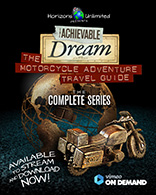Chain Adjustment + Wheel Alignment
OK, so you've used the marks on your swingarm to adjust your chain and align the wheels. You're all set, you think. Not necessarily. A closer look at adjusting your chain and aligning the wheels could save you some bucks and improve your bike's handling.
Have you ever wondered why, when you take your hands off the handlebar for a moment, your bike suddenly swoops off to one side like it had a date with the curb? Do your chain adjustments not last as long as you think they should? Perhaps the chain tightens up on you? Does it sometimes get loose quickly and then stay much the same for a long time? Ever wonder whether you should check the chain tension on or off the stand? Chain tight in one spot and loose in another?
Unfortunately, your owner's manual is of little use in answering these questions, since the factory assumes that its engineers are infallible, that everything wears evenly, that you always lube your chain at regular intervals and that you never ride in the rain. Their instructions for chain adjustment and wheel alignment are, as a consequence, inadequate.
Let's start by examining the kamikaze-into-the-curb syndrome. There are two possible reasons for this. One is that the motorcycle has been built with a weight bias to one side. However, more likely the wheels are out of alignment.
If the rear wheel is perfectly adjusted to the alignment marks on the swing arm, how can it possibly be out of alignment? First, the swingarm could have been welded together inaccurately at the factory. The marks are usually cast into the rear portion of the swingarm, and the whole assembly welded up in a jig by automatic welders. The swingarm is then mounted in a frame which is also a collection of pieces supposedly welded up perfectly.
Manufacturing tolerances are pretty good these days, but it's common to find small inaccuracies in this assembly, and any deviation alters wheel alignment. A few bikes are out as much as a whole adjustment mark, but most are out a much smaller amount. However, being out even as little as one-eighth of a notch can affect the handling of a motorcycle, and increase tire and chain wear.
Manufacturing and assembly tolerances require clearance between the axle and the adjusters, and this play can be excessive, causing a problem in retaining adjustment as well as alignment.
The key to overcoming all these inaccuracies and problems is to determine the correct wheel alignment and correct any inaccuracies in the marks, and then use a consistent method of adjustment that is easily repeatable.
Consistency is the most important aspect of chain adjustment. Always lube your chain thoroughly before adjusting, as lubing may change the tension. Use a quality chain lubricant, not motor oil, since chain lube goes on thinly to penetrate the chain and thickens into a sticky grease. The best time for lubrication is at the end of a ride when the chain is warm. The heat aids penetration of the lube into the bushings inside the chain.
Wheel alignment need only be checked once, and new marks made on the swingarm. After that, alignment can be made with respect to the new marks. There are a lot of horror stories around about using miles of string or long straight boards and spacers and hours of work, but it's not really necessary. You can tell by eye whether or not the wheels are straight. About six feet behind and about three or four inches off the ground is the best place to look from. Get a friend to help with turning the front wheel until it's in line with the rear wheel. Sighting down the side of the rear tire will quickly tell you if the rear end is cocked to one side. Moving the rear wheel in the appropriate direction will soon allow you to see both sides of the front wheel. With a little patience, you'll be amazed at how easy it is to get the rear wheel lined up with the front.

With a bit of practice, you can check your bike's wheel alignment by eye. Get down on your knees behind the bike and sight along to the front wheel. You should be able to tell if the rear wheel is cocked to the side.
When you're sure that the wheels are in line, check the alignment marks on the adjusters. If. they are the same on both sides, you're lucky. If not, assume the chain side is correct and make a new reference mark on the other side of the swingarm. You won't have to check alignment again if you use this mark and tighten the axle correctly.
To adjust the chain as accurately as possible, put the bike on the centerÂstand, or a box if your bike has no stand. Spin the rear wheel slowly and check the chain tension as the wheel turns. Note that the chain tension varies. On some bikes you get a lot of variance. This variance is caused by uneven chain stretch (remember when you dropped the clutch at 11,000 rpm?) and eccentric sprockets.
This is also a good time to check the chain for wear. Regardless of adjustment, pull one of the chain links off the rear sprocket. If the chain lifts off the sprocket more than half the height of a tooth of the sprocket, the chain is worn out. Replace it right away and you won't have to replace the sprockets as well. Sprockets must be replaced when the teeth show signs of hooking, or a difference in profile between the back and front of the tooth. Never put a new chain on a hooked sprocket.

Wear is checked by pulling chain off the rear sprocket.
Find the tightest point in the chain and mark the wheel where it would touch the ground as a reference mark. The biggest problem in setting chain tension is determining where in the wheel's travel to check it. The correct point to check it is where the chain is tightest. This occurs when the front sprocket, swingarm pivot, and rear axle are in line. The surest way of checking this is to remove the rear shocks and lift the rear wheel up until it is in position, supporting it with blocks underneath or straps tied to the seat. Don't guess at the position of the front sprocket. Remove the cover and be sure. Position the reference mark on the tire facing down so that the chain is at its tightest point. Correct chain tension at this point is approximately one-half inch of play. (12-15mm)
Loosen the axle slightly, and using the adjuster bolts draw the wheel back until the chain is correctly adjusted. If you have to move the wheel forward, loosen the axle a little more as well as the adjusters and give the wheel a good kick forward. Try to move the wheel forward a little too much so that you draw the wheel back with the adjusters, thus eliminating any clearance problems in the adjusters.
You don't want to have to remove your shocks every time your chain needs adjusting so an easily repeatable method is needed. First, with the bike on its centerstand ensure that the reference mark on the tire is facing down so that the chain is at its tightest point. Note that the slack will be more than half an inch since the front sprocket, swingarm pivot and rear axle are no longer in line, but you should be able to find a reference point that allows easy adjustment. For example, on bike A, if you lift the top run of the chain at the passenger peg, your finger will just touch the chain guard. Since you just set the chain slack to one-half inch with the shocks removed, this reference should give you an easy, quick method of checking chain tension. Experiment to find your own reference point.
The first adjustment will probably take you an hour or so, but the next time it should only take a few minutes, and you'll have the satisfaction of knowing that it's right and your wheels are in line. The adjustment will also last longer, and so will the chain.
Member login
Announcements
Thinking about traveling? Not sure about the whole thing? Watch the HU Achievable Dream Video Trailers and then get ALL the information you need to get inspired and learn how to travel anywhere in the world!
Have YOU ever wondered who has ridden around the world? We did too - and now here's the list of Circumnavigators!
Check it out now, and add your information if we didn't find you.
Are you an Overland Adventure Traveller?
Does the smell of spices wafting through the air make you think of Zanzibar, a cacophony of honking horns is Cairo, or a swirl of brilliantly patterned clothing Guatemala? Then this is the site for you!
Hosted by Grant and Susan Johnson, RTW 1987-1998
Next HU Events
HU Event and other updates on the HUBB Forum "Traveller's Advisories" thread.
ALL Dates subject to change.
2024:
- California: April 18-21
- Virginia: April 25-28
- Germany Summer: May 9-12
- Québec: May 17-19
- Bulgaria Mini: July 5-7
- CanWest: July 11-14
- Switzerland: August 15-18
- Romania: August 30-Sept 1
- Ecuador: August 24-25
- Austria: September 12-15
- France: September 20-22
- Queensland is back! Oct 4-7
- Germany Autumn: Oct 31-Nov.3
- South Africa: November
Add yourself to the Updates List for each event!
Questions about an event? Ask here
HU Achievable Dream is Online
and available now to stream on Vimeo!
ALL 15 chapters of the HU Achievable Dream Guide are available to download on Vimeo!
Binge watch over 18 hours of inspiring, informative and entertaining stories and tips from 150 travellers!
"a cross between entertaining stories, tech tips, and reference guide"
"A timeless introduction to Motorcycle Adventure Travel!"
Originally launched as a 7 DVD set, The Achievable Dream series can now be downloaded anywhere. OVER 18 hours of solid info take up zero space in your panniers. How convenient!
Books

All the best travel books and videos listed and often reviewed on HU's famous Books page. Check it out and get great travel books from all over the world.
NOTE: As an Amazon Affiliate we earn from qualifying purchases - thanks for your help supporting HU when you start from an HU Amazon link!





















Comments
Grant Johnson did a great job describing proper chain adjustment on this episode of Adventure Rider Radio.
http://www.adventureriderradio.com/adventure-rider-radio-epi...
Removing a monoshock is indeed a pain! But, otherwise there's no difference between a mono and dual shock system for this. You can compress the shock enough to do the job, which while not so easy, is possible.
A good tie down strap around the frame and swing-arm will compress it all you need. A friend pushing down and bouncing while you crank on the strap will work. I've done it alone, either sitting on the seat with the strap end coming up, and yanking up while bouncing down on the seat, or chest on the seat and using my weight and a little bounce to compress the shock, but it's definitely easier with a little help, especially if your friend is umm... big... :)
Not so easy if you have a monoshock! Any alternative?
good starting point when installing new sprockets and chain, so that maximum life can be obtained.